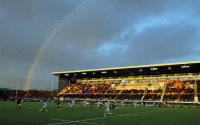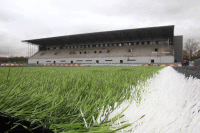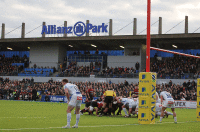Allianz Park - one year on the game has changed

For a long time, debate existed on the value of artificial turf in rugby, with concerns surrounding the scrum, safety and performance. At present, it appears opinion is shifting in favour of artificial grass as a viable alternative following its subsequent installation at Arms Park, home of the Cardiff Blues.
Speaking on how the surface has silenced doubters, Allianz Park Stadium Director, Gordon Banks, said; "the most obvious endorsement of our judgement was the team finishing top of the league last year. Clearly that isn't entirely down to the turf, by any means, but it completely negates any argument that the surface would adversely affect play".

"Whilst I am pleased, more importantly, the team is very happy with the turf and my board is delighted with what it has done for the club's profit and loss."
The financial benefits of going synthetic are arguably the greatest incentives for clubs mulling over the decision. Now that the turf has been proven to tick boxes of performance, play and safety, there are grounds to expect even more clubs, across a multitude of sports, to follow suit.
The ability of artificial turf to generate additional revenue is substantial, with some pitches helping to bring in over £200,000 per year in new income, something unachievable with natural pitches. By allowing the proprietor to use the turf all year round, regardless of what the elements can throw at it, synthetic pitches play a crucial role in helping clubs achieve a stable long-term future. Further savings on water and pesticides, in addition to its enhanced durability, ensures maintenance is kept to a minimum.

Questions over the pitch's safety have also proved foundless as the feared burns and injuries have, up until now, not materialised. As resistant to sun as much as rain, a synthetic pitch also provides greater protection on impact than a hard, natural equivalent during periods of intense heat. A consistent surface and incorporated shock absorption pads provide added protection. Effective pitch care, as implemented at Allianz Park by Maintenance Manager, Danny Holding, is also behind the pitch's safety record.
"Every week, the pitch gets a rake and a sweep," explains Danny, "and we also make sure that there are sufficient levels of rubber crumb below the level of the grass. The raking is important to ensure that all the fibres are standing upright and not lying flat, so that there's no risk of burns to the players. The rubber crumb provides that 'natural' give in the pitch when players plant their feet, so that we minimise the threat of joint injuries."
"Whilst we don't use pesticides, the pitch does need to be treated and we are due for our first one soon. It's very simple and just protects against any bacteria getting caught within the fibres."

"There was always a concern around the 3G pitch and there were some reports of studies saying that it was slightly more prone to causing injury," says Senior Physiotherapist, Laura Tulloch. "We haven't found that, particularly with grass soft tissue injuries. There's obviously a faster game played on this pitch, and you see that in the games that we play and the tries that we are scoring, but we haven't found a particular correlation between the change in our injury history and the pitch coming in."
The cost to maintain a synthetic pitch ranges from between £15,000 to £20,000 a year and, whilst groundstaff are still required, it's the return on the investment that makes the turf stand out. Saracens new found ability to assist the community is testament to that.
How synthetic would affect Saracens play style was one of the more intriguing questions upon its installation. Fans, who had always enjoyed high quality rugby at Vicarage Road, waited with bated breath to see if theories of a faster game would come true. They did, and with devastating effects. Prior to Saracens defeat to London Irish, the team had racked up 622 points, scoring seventy-four tries and winning sixteen of their seventeen games at home.

Key to that development is Joe Shaw, Saracens Skill Coach. The club currently utilises two bases for training, one is their synthetic pitch and the other is the grass pitches at St. Albans in preparation for clashes on natural turf. With experience on both, it's clear which one he prefers.
"The pitch has changed the game for us really in terms of how we have managed to evolve our attack and our general game. The boys enjoy playing down here, they know what they are going to get week in week out, and it has allowed us to execute things at a pace that not a lot of teams have experienced before. I think it is the future for a lot of people."
The main question surrounding the new turf was what it would do for the scrum, a facet of rugby which has seen a rapid and disappointing decline over recent years. Often collapsing and targeted by cheats looking to disrupt the game, scrums take up one-sixth of matches in the top leagues. Natural pitches, struggling to cope under heavy rainfall, do little to help, as the ground gives way under 800kg of pack power.
Yet, the pitch at Allianz Park has had little issue, having successfully seen fewer collapsed scrums on its surface. It seems, with all the ineffective rule changes surrounding scrummaging, the answer to the problem may be found underfoot.

The expertise in the installation and maintenance of synthetic turf has been partnered with Bonar Yarns, the company whose product is used on the surface. Each operation brings its own benefit to the table, incorporating shock pads - which maximise player performance - whilst Bonar's specially formulated polymer facilitates the resistance and durability that has seen Allianz Park celebrated to this day. Bonar also employ CoolGrass technology which reflects the sun and keeps the surface cool and players comfortable.
Bryn Lee is Commercial Director at Bonar Yarns. A rugby man, he is thrilled that the sport, spearheaded by Saracens, is once again leading the charge in embracing technology.
"Saracens and Allianz Park have done wonders for the image of synthetic turf. We've gone from being an unknown entity, to something that is seriously considered as a valuable asset to any club. Saracens pitch has silenced all the doubters and the fact Cardiff Blues installed their own surface shows that its popularity is growing. The great thing about 3G turf is that it provides the same benefits to elite clubs as it does to junior, colts and women's rugby. We hope and expect to see even more teams utilise synthetic in the future."

Football has been less amenable to the technology, largely due to the financial firepower at its disposal. With Premier League teams able to maintain excellent natural playing surfaces all year round, there is little need for it. For lower league clubs the story is different. Maidstone United of the Rhyman League has its own artificial pitch and it is for these clubs where the benefits will be felt the most. It may not be too long before Saracens lesson can be experienced elsewhere.
